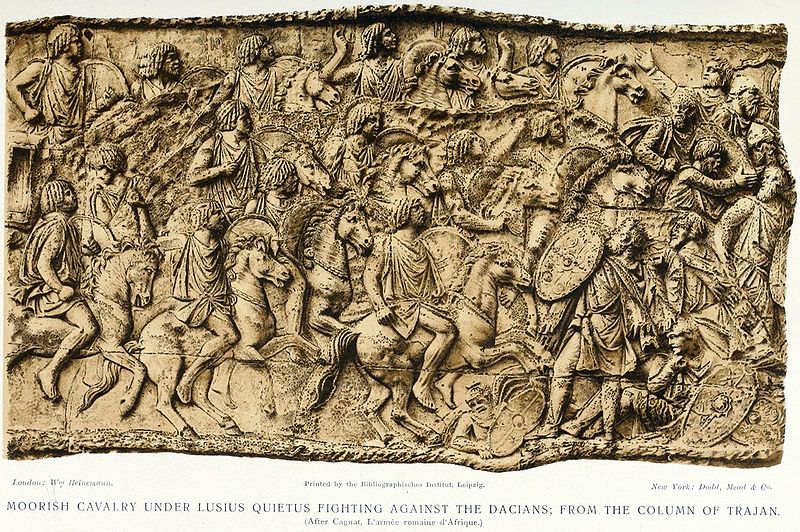 Lusius Quietus, Commander of the Imperial Cavalry of the Romano-Moorish Army:
Lusius Quietus, Commander of the Imperial Cavalry of the Romano-Moorish Army:
Here one finds the relief of the Moorish Cavalry of the Roman Army under Lusius Quietus, fighting against the Dacians. It was commissioned by Emperor Trajan. Lusius Quietus was a Roman general and governor of Iudaea in 117.
These are the real Maures, the true Maures, the ones known to the world as the Moors.
Their hair was wooly like the hair on sheep-skin. They were all dreadlocks, and fierce warriors.
Their skin was dark and beautiful. Magnificient like the mystical night. Their teeth were white, like the stars of the southern hemisphere.
They were the master horsemen of yore-days. The original cavalry of the Roman Empire. The Emperor of Rome was beholden to them, because the cavalry division was like the tanks and helicopters units of the modern army. Without them no wars were winnable. With them, victory was a matter of time.
They were not the infantry, or the legionaires. Those were lesser breed soldiers compared to the now defunct Imperial Cavalry of Rome.
Maucastraum:
Those Maurish were the peace makers of yore. They governed and maintained order in the European section of the Roman Empire. They were stationed in Britain, along the Rhine River in today’s Germany and France; they were stationed in Illyrica overseeing the areas that are now Serbia, Albania, Bulgaria and Romania.
According to one source:
“An original brass military diploma which dates from the middle of the second century A.D mentions Moorish soldiers in Moesia,which is modern Serbia.
Another military diploma A.D 158 speakes of Moorish soldiers from Africa in Dacia, or modern Romania,and also of auxiliary troops of the Dacian Moors.
A Roman document, Notitia Dignitatum, which dates from the beginning of the fifth century A.D; mentions several Moorish battalions in the Balkans and Moorish military colony Ad Mauros which was located on the Inn river near Vienna; and in what is modern Beseribia, there was a city called Maurocastrum. The BlackCastle.
According to the document Notitia Dignitatum,2500 to 5000 Illyrian Moorish soldiers, in five separate military units,had served in the Near East.From this document we must deduce that at the beginning of the fifth century at least 100,000 descendants of Moors lived in Illyrium, which was located in the Balkans.”
The Maurish cavalry battalions were so skillful in horsemanship that many of them rode without saddles, nor bits nor straps, and never any whip. They were one and the same with their horses.
They introduced the code of chivalry into Europe. For those military Roman administrators became the upper-class of their separate Dioscese, and regions of Europe following the chaos that over took Rome on its conquest by the Goths.
Those Maures then were the first Knights of Europe. For as we clearly see, since at least the days of the Roman Empire, Black African Knights had stamped their fear and authority in Europe, and established the code of nobility and chivalry, which the white Europeans so cherish today as the heritage of their “ancestors”.
Again, here one finds the relief of the Moorish Cavalry of the Roman Army under Lusius Quietus, fighting against the Dacians. The Dacians were a mixed lot of Europeans, steming from a branch of the Nigri-latinis and straggling immigrants from central Asia. The black African Knights of the Roman Empire helped put them under law and order.
Behold the Maures of the Roman Empire who ruled Europe.
Behold Lusius Quietus, the first Knight:

Oguejiofo Annu
October 9th 2010

